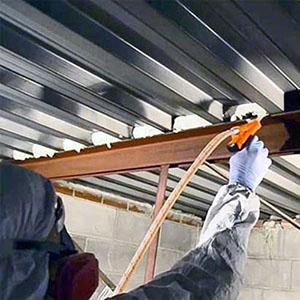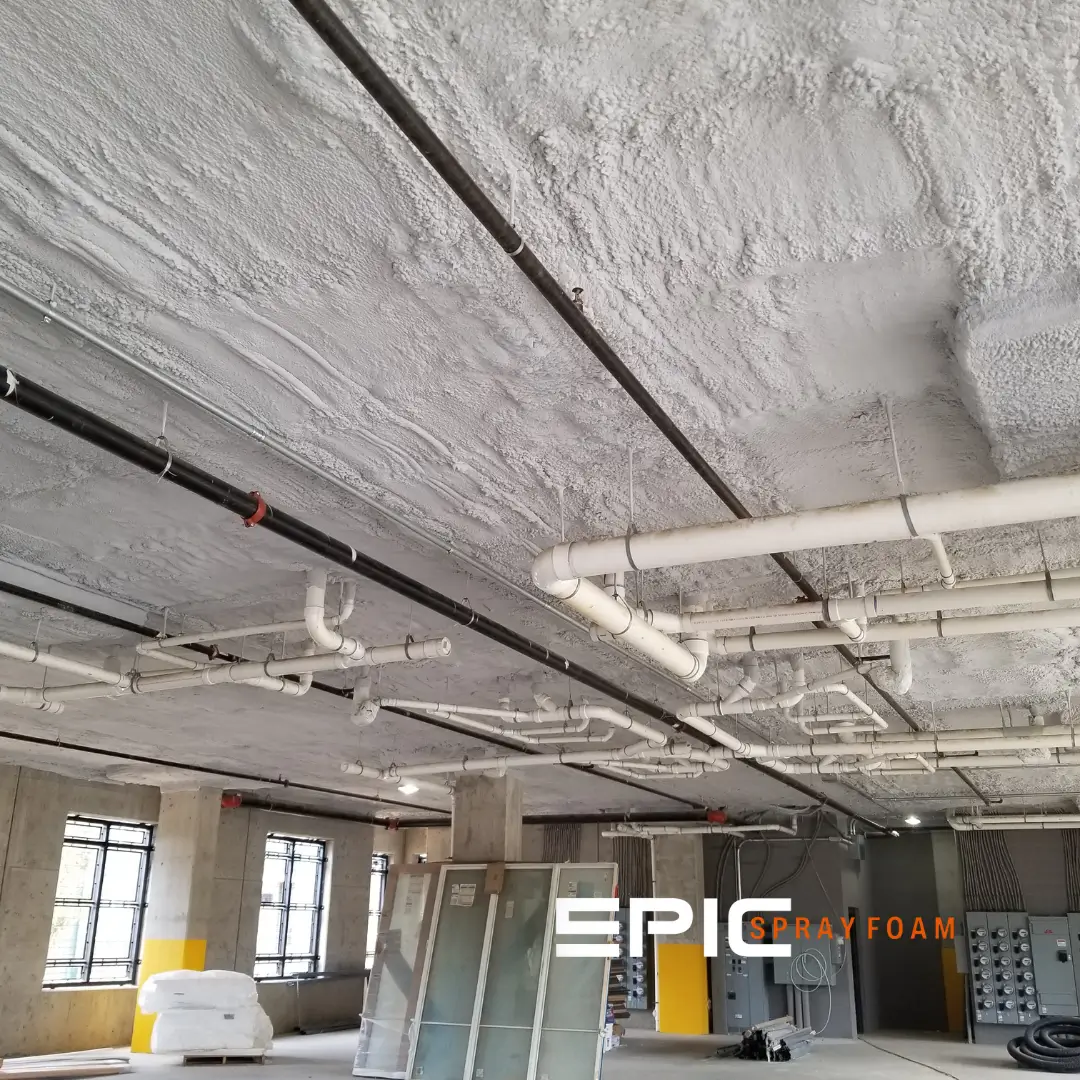The Environmental Impact of Spray Foam: Sustainability Factors To Consider
Spray Foam: The Ultimate Solution for Air Sealing and Insulation
Spray foam insulation has actually become a leading remedy for reliable air securing and thermal insulation, supplying a special mix of homes that set it besides standard approaches. Its capability to expand and fill gaps makes it particularly effective in preventing air leak, which can substantially influence power effectiveness. Nevertheless, comprehending the full range of its benefits, setup processes, and contrasts with various other insulation kinds is vital for making educated choices. As we explore these facets, the effects for both new constructions and retrofits become significantly considerable. What aspects should influence your choice?
What Is Spray Foam?
Spray foam is a flexible insulation product that integrates the concepts of air sealing and thermal resistance to improve power performance in buildings. Composed mostly of polyurethane or various other comparable substances, spray foam is applied as a fluid that expands upon contact with surface areas, producing a solid, constant layer of insulation. This one-of-a-kind property enables it to load spaces, fractures, and gaps that conventional insulation products might neglect, providing an exceptional air seal.
There are two primary kinds of spray foam: open-cell and closed-cell. Open-cell spray foam is lighter and extra flexible, using outstanding audio absorption and a reduced R-value per inch - Spray Foam. In contrast, closed-cell spray foam is denser, offering a higher R-value, wetness resistance, and included architectural integrity to building elements
The application process typically involves specific tools, ensuring a seamless application that abides by various substrates, including concrete, metal, and wood. This adaptability makes spray foam suitable for both new buildings and retrofitting existing structures. Its capability to produce a closed barrier considerably adds to decreasing power intake and improving interior air high quality, therefore making it a recommended option among house owners and building contractors alike.
Advantages of Spray Foam Insulation
Among the most significant benefits of spray foam insulation is its extraordinary capacity to develop a constant air obstacle, which successfully reduces power loss. Unlike conventional insulation materials, spray foam increases to fill up gaps and splits, making sure that air leakage is drastically minimized. This characteristic not just improves energy performance however additionally causes lower energy costs gradually.
Furthermore, spray foam insulation gives exceptional thermal resistance, adding to a more steady indoor atmosphere. Its high R-value per inch allows for efficient insulation in constrained spaces, making it excellent for attics, wall surfaces, and crawl spaces. The moisture-resistant residential or commercial properties of spray foam assistance protect against mold and mildew and mold development, promoting much healthier living problems.
Another vital benefit of spray foam insulation is its sound-dampening high qualities (Spray Foam). It successfully lowers noise transmission between rooms, producing a quieter and extra comfy home environment. The sturdiness of spray foam likewise attracts attention, as it does not droop or work out gradually, keeping its efficiency throughout its life-span
How Spray Foam Works
Understanding exactly how spray foam insulation functions is necessary for valuing its performance in air securing and thermal resistance. Spray foam insulation is composed of 2 Resources primary elements: isocyanate and polyol resin. When these elements are mixed, they go through a chemical reaction that triggers dig this the product to increase quickly, producing a dense foam that fills dental caries, fractures, and gaps.
As the foam increases, it sticks to surfaces, creating an impermeable seal that dramatically minimizes air infiltration. This particular makes spray foam insulation extremely efficient at preventing drafts and wetness penetration, which can bring about energy loss and damages gradually. In addition, the closed-cell variant of spray foam provides exceptional thermal resistance because of its rigid framework, efficiently reducing heat transfer.
The special properties of spray foam allow it to comply with irregular surface areas, guaranteeing comprehensive protection and a seamless barrier. As an outcome, spray foam insulation not only boosts energy performance but likewise adds to improved indoor air quality by minimizing the accumulation of toxins and allergens. Eventually, recognizing the mechanics behind spray foam highlights its duty as an exceptional option for insulation and air securing in both commercial and domestic applications.
Setup Process Overview

Before installation, the area needs to be adequately cleansed and prepped, ensuring that surfaces are without dust, particles, and dampness. This action is crucial Home Page because contaminants can endanger adhesion and overall performance. When the area is prepared, the application involves mixing the two components of the spray foam, which increases upon call and loads spaces successfully.
Trained specialists ought to perform the setup, making use of specialized tools to make certain consistent coverage and optimal density. Safety and security precautions, including putting on protective gear and ensuring correct ventilation, are crucial throughout this process. After application, the foam generally cures swiftly, developing a strong barrier that enhances power effectiveness.
Comparing Spray Foam to Standard Insulation
When reviewing insulation options, spray foam insulation stands out in contrast to typical materials such as fiberglass and cellulose. Unlike fiberglass and cellulose, which can enable air infiltration, spray foam expands upon application, loading gaps and crevices to produce an impermeable seal.
Additionally, spray foam offers a greater R-value per inch than typical insulation types, using even more effective thermal resistance in a thinner profile. This characteristic is especially beneficial precede with restricted tooth cavity deepness. Furthermore, spray foam is resistant to moisture and mold growth, which can be a considerable interest in cellulose and fiberglass, especially in moist settings.
However, spray foam insulation usually brings a higher upfront cost than its traditional counterparts. Property owners should evaluate this initial investment versus lasting power financial savings and performance advantages. Eventually, while both insulation types serve their objective, spray foam arises as a much more advanced solution for modern-day insulation requirements, especially in terms of air securing and thermal effectiveness.

Final Thought
In recap, spray foam insulation stands for a highly efficient option for attaining ideal air securing and thermal resistance. Its unique buildings, consisting of moisture resistance and sound dampening, make it appropriate for different applications in both brand-new building and constructions and retrofitting jobs (Spray Foam). Although the initial expenses may be greater compared to conventional insulation products, the long-term benefits, such as substantial power cost savings and boosted indoor air top quality, justify the financial investment and highlight its value in modern building practices.
Spray foam insulation has actually emerged as a leading service for effective air securing and thermal insulation, supplying an one-of-a-kind mix of properties that set it apart from conventional methods.Spray foam is a functional insulation product that combines the concepts of air sealing and thermal resistance to enhance power effectiveness in buildings.When reviewing insulation choices, spray foam insulation stands out in comparison to typical materials such as fiberglass and cellulose. Ultimately, while both insulation kinds serve their purpose, spray foam arises as a more innovative service for modern insulation requirements, especially in terms of air securing and thermal effectiveness.
In recap, spray foam insulation represents a highly efficient solution for accomplishing optimal air securing and thermal resistance.